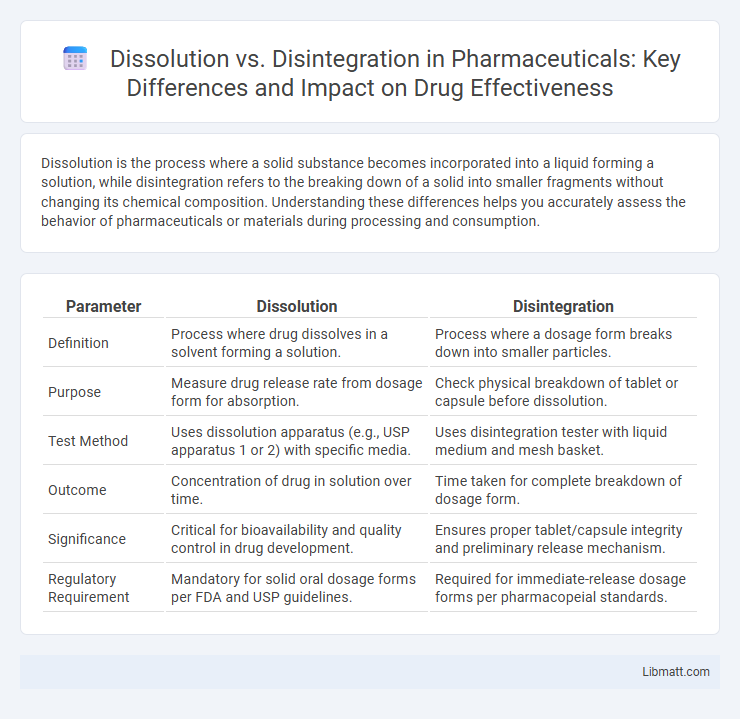Dissolution is the process where a solid substance becomes incorporated into a liquid forming a solution, while disintegration refers to the breaking down of a solid into smaller fragments without changing its chemical composition. Understanding these differences helps you accurately assess the behavior of pharmaceuticals or materials during processing and consumption.
Table of Comparison
| Parameter | Dissolution | Disintegration |
|---|---|---|
| Definition | Process where drug dissolves in a solvent forming a solution. | Process where a dosage form breaks down into smaller particles. |
| Purpose | Measure drug release rate from dosage form for absorption. | Check physical breakdown of tablet or capsule before dissolution. |
| Test Method | Uses dissolution apparatus (e.g., USP apparatus 1 or 2) with specific media. | Uses disintegration tester with liquid medium and mesh basket. |
| Outcome | Concentration of drug in solution over time. | Time taken for complete breakdown of dosage form. |
| Significance | Critical for bioavailability and quality control in drug development. | Ensures proper tablet/capsule integrity and preliminary release mechanism. |
| Regulatory Requirement | Mandatory for solid oral dosage forms per FDA and USP guidelines. | Required for immediate-release dosage forms per pharmacopeial standards. |
Understanding Dissolution and Disintegration
Dissolution refers to the process where a substance, usually a solid, dissolves into a solvent, forming a solution, while disintegration involves the physical breakdown of a solid into smaller fragments without changing its chemical composition. Understanding dissolution requires analyzing how molecules interact at the molecular level, affecting the rate at which a drug releases active ingredients into the body. Your ability to distinguish between these processes is crucial for optimizing drug formulation and ensuring effective therapeutic outcomes.
Key Definitions: Dissolution vs Disintegration
Dissolution refers to the process by which a solid substance dissolves in a solvent, forming a homogeneous solution at the molecular or ionic level. Disintegration involves the physical breakdown of a solid dosage form, such as a tablet, into smaller particles without necessarily dissolving the substance. Understanding the distinction between dissolution and disintegration is crucial for optimizing drug delivery and ensuring that Your medication performs effectively in the body.
Chemical Processes Behind Dissolution
Dissolution involves the chemical process where solid molecules or ions separate and evenly disperse into a solvent, creating a homogeneous solution through molecular interaction and solvation. Unlike disintegration, which refers to the physical breakdown of a solid into smaller particles, dissolution depends on solvent polarity and solute-solvent affinity to effectively break ionic or covalent bonds. Understanding these chemical processes helps you optimize formulations and enhance solubility in pharmaceutical or industrial applications.
Physical Mechanisms of Disintegration
Disintegration involves the physical breakdown of a solid dosage form into smaller fragments, primarily driven by mechanical forces such as swelling, capillary action, and the dissolution of binding agents within the formulation. This process increases the surface area available for dissolution by overcoming the structural integrity of the tablet or capsule matrix. Unlike dissolution, which is a molecular-level process involving solute-solvent interactions, disintegration focuses on the macroscopic fragmentation of the dosage form to facilitate subsequent dissolution.
Factors Affecting Dissolution Rates
Dissolution rates are influenced by factors such as particle size, surface area, and solubility of the substance. Temperature, agitation speed, and the composition of the dissolution medium also play critical roles in determining how quickly a solid dissolves. Understanding these factors is essential for optimizing drug formulation and ensuring consistent bioavailability.
Influences on Disintegration Behavior
Disintegration behavior is primarily influenced by factors such as the formulation's composition, granule size, and presence of disintegrants that promote rapid break-up of the solid dosage form. Environmental conditions like pH, temperature, and agitation intensity during testing significantly impact the disintegration rate. Understanding these influences helps optimize your pharmaceutical product's performance and ensure consistent therapeutic efficacy.
Real-World Applications of Dissolution
Dissolution plays a critical role in pharmaceutical development, determining the rate at which a drug releases active ingredients into the body, directly affecting bioavailability and therapeutic effectiveness. In environmental science, dissolution helps assess how pollutants or minerals break down in water, influencing ecosystem health and remediation strategies. Your ability to understand dissolution kinetics enables optimized formulation and improved environmental impact assessments.
Practical Uses of Disintegration in Industry
Disintegration plays a critical role in various industries by breaking down solid materials into smaller particles to enhance processing efficiency. In pharmaceuticals, disintegration ensures tablets quickly break apart in the digestive tract for faster drug absorption. Your manufacturing operations benefit from improved material handling, increased surface area for reactions, and optimized mixing through controlled disintegration processes.
Comparative Analysis: Dissolution vs Disintegration
Dissolution refers to the process where a solid substance completely dissolves into a solvent, forming a homogeneous solution, while disintegration involves the physical breakdown of a solid into smaller fragments without necessarily dissolving. In pharmaceutical contexts, dissolution is critical for drug bioavailability as it measures the rate at which the active ingredient goes into solution, whereas disintegration indicates how quickly a tablet or capsule breaks apart in the digestive system. Understanding the comparative differences between dissolution and disintegration helps you optimize drug formulation and ensure effective therapeutic outcomes.
Choosing the Right Process: Key Considerations
Choosing the right process between dissolution and disintegration depends on the specific application and desired outcome in drug delivery or material testing. Dissolution measures the rate at which a substance goes into solution, crucial for bioavailability and therapeutic efficacy, while disintegration assesses the physical breakdown of a tablet or capsule, important for ensuring proper dosage form performance. Factors such as drug solubility, formulation type, and target release profile guide the selection to optimize treatment effectiveness and compliance.
Dissolution vs Disintegration Infographic

 libmatt.com
libmatt.com